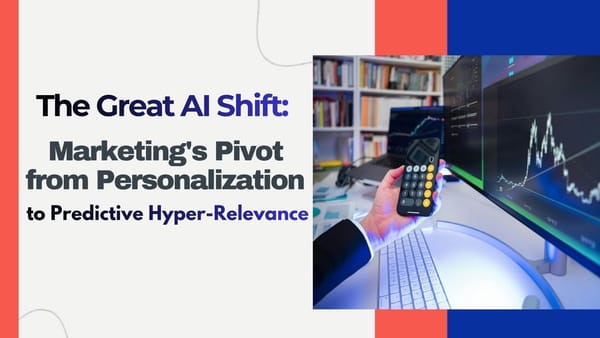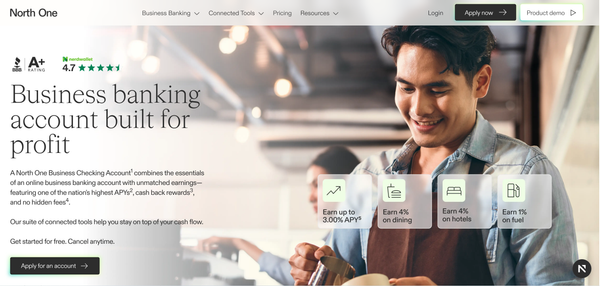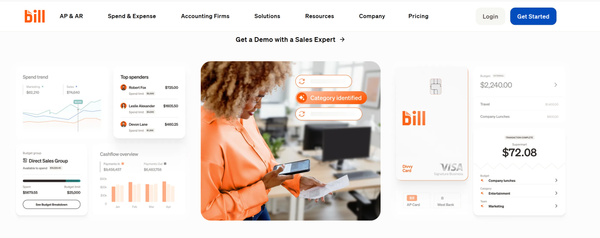Boosting Conversion Rates with Time- & Trigger-Based Email Nurturing Campaigns
Engage leads at the right time with personalized, automated emails. Unlock the power of timely and behaviour-driven emails to transform leads into loyal customers.
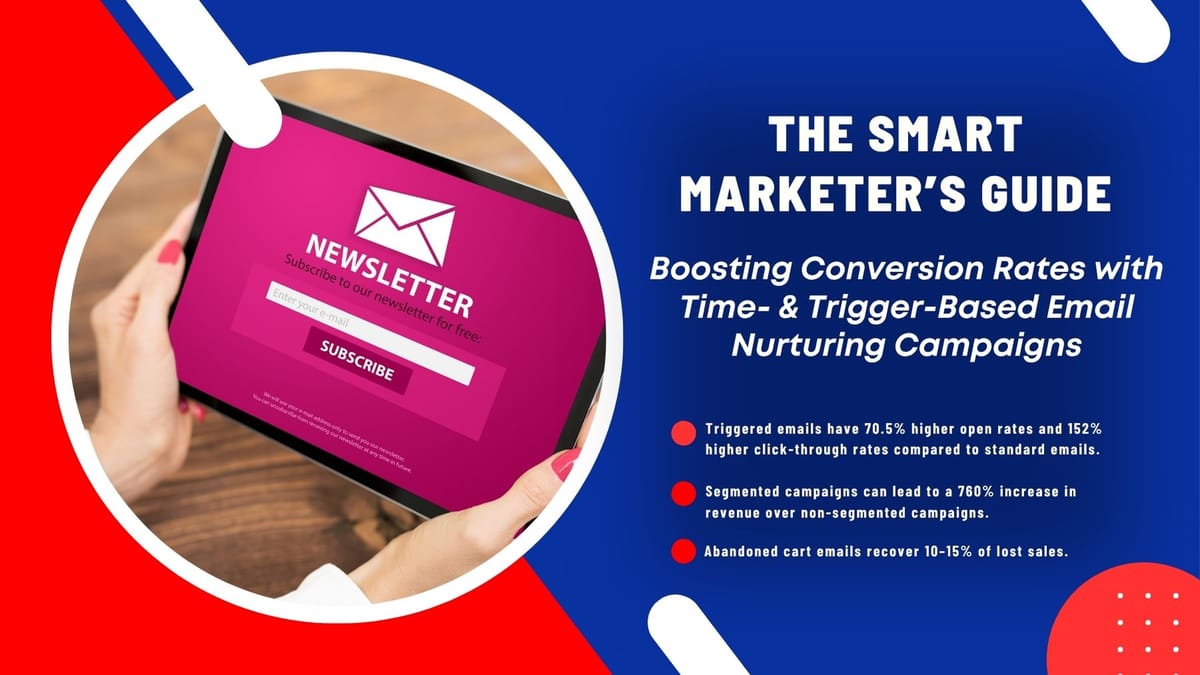
What if your emails could think for you? What if every message you sent arrived at the exact moment your subscriber needed it—without lifting a finger?
For too many marketers, email is still a static tool: same blast, same time, same message—for every subscriber. But in 2025, with inboxes more crowded than ever, one-size-fits-all won’t cut it. Fortunately, you don’t need more emails. You need smarter ones.
In this guide, we’ll show you how to use time- and trigger-based email nurturing campaigns to skyrocket your conversion rates, drive engagement, and turn leads into loyal customers—on autopilot.
Whether you’re in affiliate marketing, tech, lifestyle, or SaaS, these strategies will work for you. With real examples, emotional storytelling, and an actionable checklist, you’ll walk away with a blueprint to implement today.
🧠 What is Email Nurturing—and Why It Matters
Email nurturing is the process of building a relationship with potential or existing customers through automated, personalized communication over time.
But nurturing isn’t just about sending emails. It’s about sending the right message at the right time, aligned with your subscriber’s stage in the customer journey.
There are two core ways to do this:
- Time-Based Campaigns: These run on a schedule (e.g., Day 1: Welcome Email; Day 3: Feature Spotlight).
- Trigger-Based Campaigns: These are activated by user behaviors (e.g., link clicks, cart abandonment, signups).
Together, they form the automated brain behind your email funnel—responding dynamically to user intent.
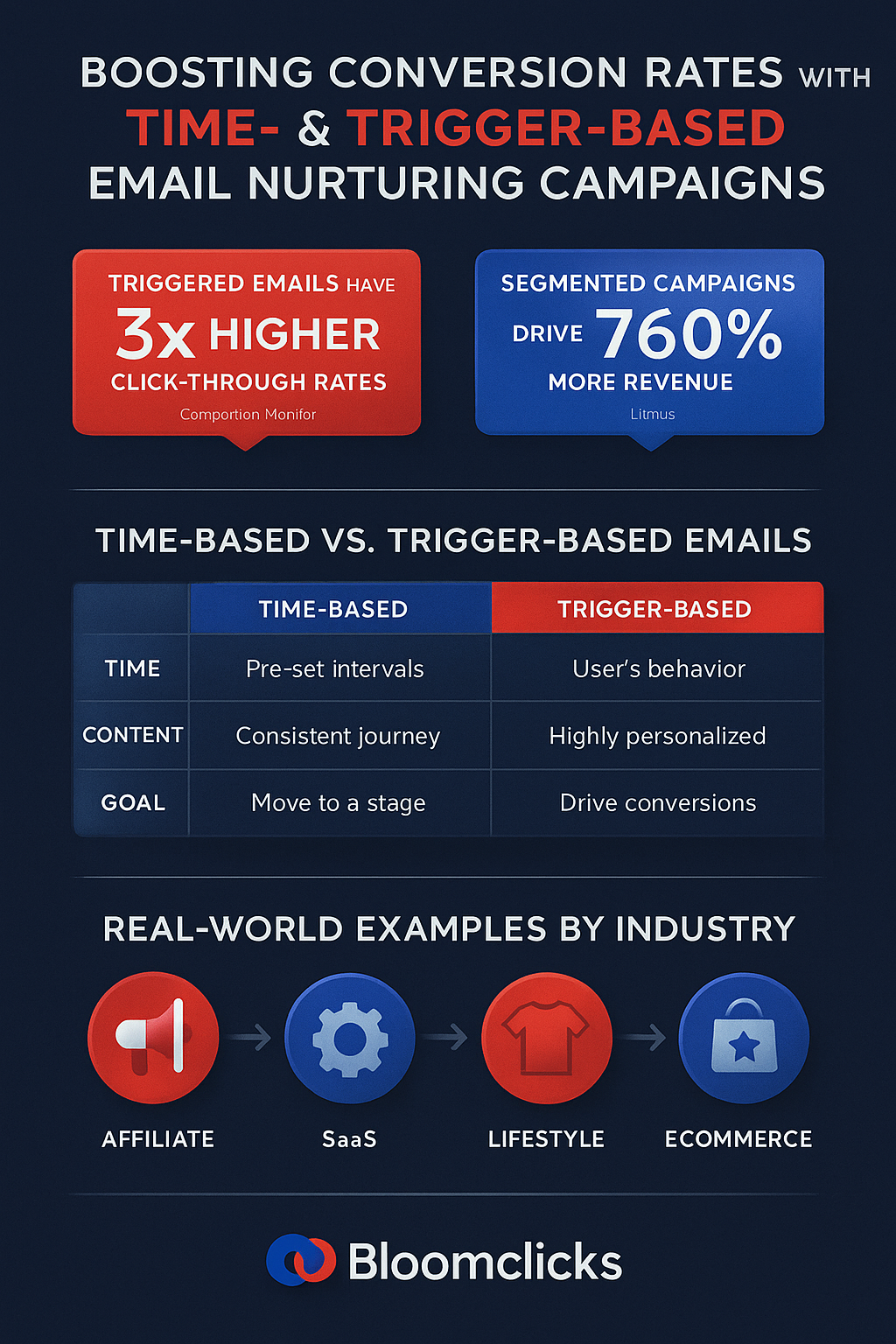
⏱️ Time-Based vs 🎯 Trigger-Based Email Campaigns
To create a high-converting email nurturing campaign, it's essential to understand the two foundational strategies that power automation: time-based and trigger-based emails. While they serve different functions, combining them creates a dynamic, intelligent system that aligns with the psychological flow of your audience’s behavior and decision-making.
⏱️ Time-Based Email Campaigns
(Structured nurturing with strategic timing)
Time-based emails are sent at predefined intervals, regardless of a subscriber's behavior. These campaigns are perfect for delivering consistent, educational, and progressive value over a defined time period. Think of them as your guided story arc.
📘 Use Case:
- Welcome Series: Send a sequence of emails after a new subscriber signs up—introduce your brand, showcase core benefits, and offer a next-step CTA.
- Onboarding Flow: Guide new users through your product or service experience over 7–10 days.
- Content Drip Series: Educate and inform over time with a multi-part series (e.g., "5 Steps to Build a Sales Funnel").
🧠 Why It Works (Emotional & Cognitive Insight):
- Predictability builds trust: Regular cadence creates psychological safety and familiarity.
- Progressive education: Builds understanding gradually, reducing decision fatigue.
- Anticipation effect: When structured like a story, users begin to anticipate value.
🎯 Trigger-Based Email Campaigns
(Real-time, behavior-responsive messages)
Trigger-based emails are event-driven and sent in response to specific user actions or inactions. These emails deliver timely, personalized content based on real behavior, making them feel relevant and human—even though they’re automated.
📘 Use Case Examples:
- Cart Abandonment: If a user leaves items in their cart, send a reminder 30 minutes later with a discount or social proof.
- Behavioral Re-engagement: If a user hasn’t logged in for 7 days, send a check-in or incentive email.
- Milestone Achievements: Celebrate a user completing a task, downloading a resource, or reaching a usage goal.
🧠 Why It Works (Emotional & Cognitive Insight):
- Timely relevance: The human brain is wired for context; trigger emails arrive at high-intent moments.
- Sense of being seen: Personalization and responsiveness enhance emotional connection and reciprocity.
- Loss aversion: Triggered urgency (like limited offers after abandonment) taps into the psychological fear of missing out (FOMO).
🔁 Comparison Snapshot
| Feature | Time-Based Emails | Trigger-Based Emails |
|---|---|---|
| Send Basis | Fixed schedule (e.g., Day 1, Day 3) | User behavior or event-based |
| Best For | Onboarding, welcome flows, drip education | Cart recovery, re-engagement, personalization |
| Psychological Hook | Predictability, anticipation | Relevance, timing, urgency |
| Setup Complexity | Easier to implement | Requires behavioral data + logic |
| Engagement Potential | High over time with storytelling | High immediately due to relevance |

🧩 Combining Both for Maximum Impact
The real magic happens when you use both approaches in harmony:
- Start with a time-based sequence to educate, build trust, and guide the customer journey.
- Layer in trigger-based messages to respond to key behaviors, re-engage inactive users, or accelerate action at critical moments.
💬 Example: A SaaS brand sends a 7-day onboarding sequence (time-based). If a user opens but doesn’t click on the "Book a Demo" CTA by Day 4, a personalized trigger email offers a one-on-one call or a product video demo.
🔧 Emotional Intelligence Tip:
Incorporating emotional resonance in both types of campaigns strengthens connection and increases conversion. Use empathetic copy like:
- "We noticed you haven't found what you're looking for—can we help?" (compassionate trigger)
- "You're halfway through your journey—keep going!" (motivational time-based)
When automated campaigns reflect timing, personalization, and emotional relevance, your emails stop feeling like marketing—and start feeling like real relationships.
💡 Why These Campaigns Drive Higher Conversion Rates
The effectiveness of time- and trigger-based email campaigns is deeply rooted in both behavioral psychology and modern marketing science. Let’s explore why they work so well—and how they drive more conversions than static email blasts.
1. Relevance is the New Personalization
In the attention economy, relevance is currency. Trigger-based emails respond to what users are doing now, making every interaction feel intuitive and tailored.
🧠 Cognitive psychology insight: People respond more positively to stimuli that reflect their current actions or decisions. This creates what’s known as the “recency effect,” where recent experiences shape perception and behavior.
2. Timing Builds Trust and Momentum
A well-structured time-based sequence builds psychological safety. The user feels guided—not sold to. The pacing allows them to absorb, reflect, and gradually commit.
"The average email open rate increases by up to 47% when timing aligns with user behavior." – Litmus, 2024
3. Trigger Emails Tap into Emotional Urgency
- Cart abandonment emails trigger loss aversion
- Reactivation emails tap into curiosity or guilt
- Behavioral nudges create micro-momentum (“You’re almost there!”)
These emotional touchpoints are what transform passive subscribers into engaged buyers.
4. They Scale Human Connection
When done right, automated emails don’t feel automated. They feel like someone is watching, helping, responding. That emotional responsiveness builds brand loyalty.
🔧 Best Practices for Building High-Converting Email Nurturing Campaigns
Setting up a high-performing email nurturing system is both a strategic and empathic task. Here’s a breakdown of best practices, rooted in marketing performance and emotional intelligence.
✅ 1. Define Your Objective by Stage
Each email (and sequence) should map to a distinct stage of the customer journey:
- Awareness → Educate
- Consideration → Differentiate
- Decision → Convert
- Loyalty → Nurture and Upsell
🎯 Pro Tip: Don’t try to achieve multiple outcomes in one sequence. Confusion reduces conversion.
✅ 2. Use Segmentation to Refine Message Fit
Tailor emails by audience characteristics:
- Source of signup (e.g., affiliate, ad, organic)
- Stage of lifecycle
- Behavior history (purchases, site visits, inactivity)
"Segmented campaigns see a 760% increase in revenue." – Campaign Monitor
✅ 3. Balance Time- and Trigger-Based Logic
Use time-based campaigns to deliver structure (e.g., onboarding), and trigger-based campaigns to respond with relevance (e.g., cart abandonment or re-engagement).
📈 Example: A SaaS company sends a 5-day time-based onboarding flow. If the user doesn’t activate a key feature by Day 3, a trigger email prompts them with a quick-start video.
✅ 4. Focus on Emotional CTAs
The best calls to action are emotionally driven, not just action-oriented.
Compare:
- ❌ “Click here for your discount”
- ✅ “Your special reward is waiting—grab it before it expires”
Tap into curiosity, exclusivity, or empowerment.
✅ 5. Optimize Subject Lines for Intent
Time-based: Use intrigue or value-driven clarity.
Trigger-based: Reflect the context or consequence.
Examples:
- 🕒 “Welcome to the Journey—Start Here” (time-based)
- ⚡ “You left something behind…” (trigger-based)
- 🤔 “Still deciding? Here’s what others loved” (trigger + social proof)
✅ 6. Mobile-First Design is Mandatory
- Use 1-column layouts
- CTA buttons > links
- Short subject lines (<40 characters)
📱 60%+ of email opens now happen on mobile—ensure every email is swipe-friendly and fast to load.
✅ 7. Measure and Optimize with Precision
Track:
- Open rates (subject line + send time)
- Click-through rates (offer clarity + design)
- Conversion rates (landing page + CTA alignment)
- Unsubscribe rates (messaging fatigue or misalignment)
📊 A/B test frequently: Especially subject lines, CTA buttons, email timing, and content blocks.
✅ 8. Use Emotional Microcopy Throughout
Emotionally intelligent copy helps people feel seen and understood. Use empathetic phrases like:
- “We know choosing [X] isn’t easy…”
- “You’re not alone—thousands have felt this way.”
- “Still curious? Let’s explore together.”
This strengthens trust and emotional engagement, leading to higher click-through and conversion rates.
✅ 9. Create Feedback Loops
Let users control the experience:
- “Want fewer emails?” → Link to preferences
- “Was this helpful?” → Include a quick feedback poll
- “Tell us what you want to see next” → Data goldmine for personalization
✅ 10. Automate, but Stay Human
Even in automation, never lose the emotional tone of a real conversation. Sign off with real names, add voice, use plain language—not robotic marketing jargon.
The paradox of automation is that the more human it feels, the better it performs.
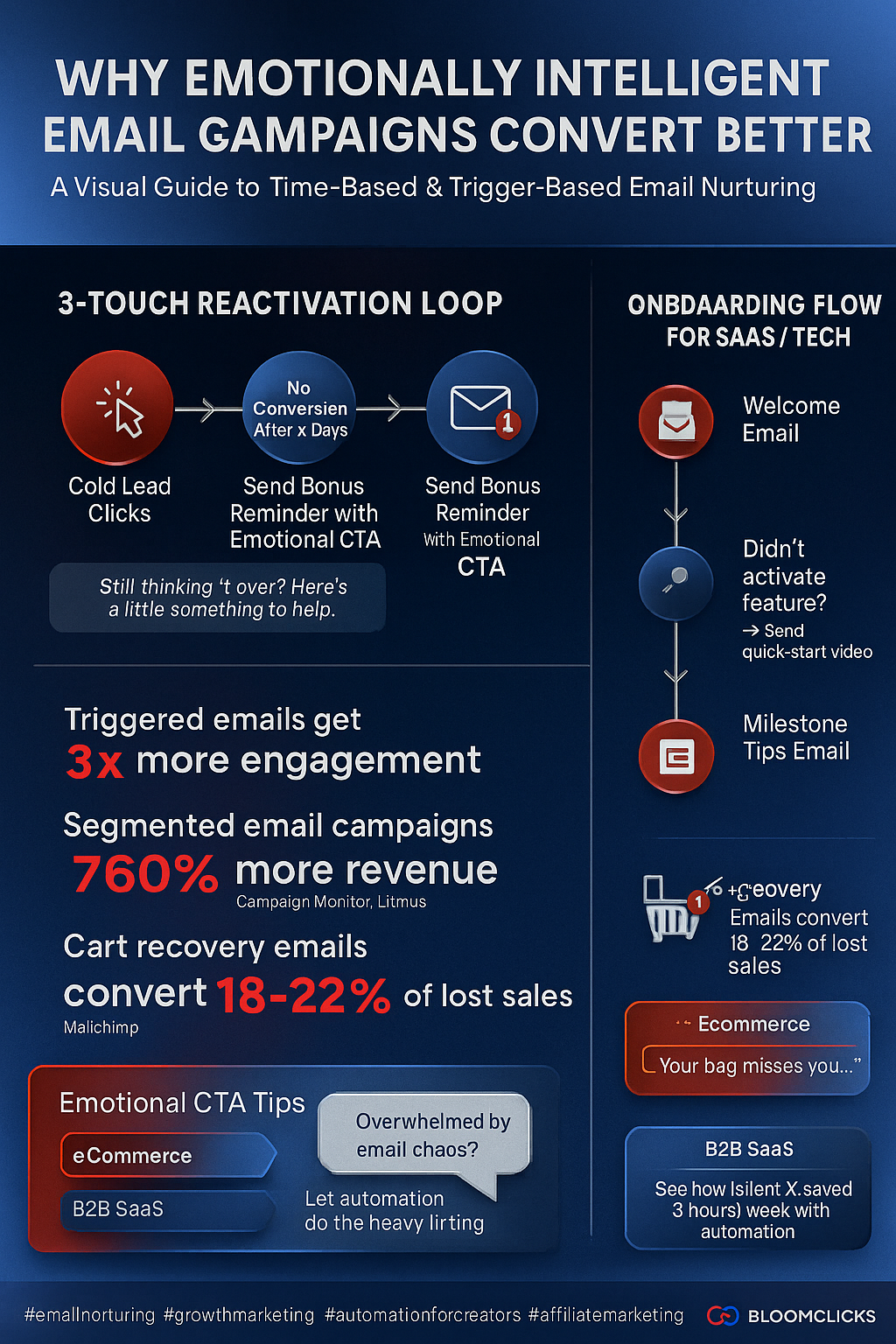
🖥 Platform-Specific Content Strategy: Why This Works Everywhere
Your email campaign content is only one piece of the puzzle. Repurposing the same insights across different platforms ensures maximum reach, sustained visibility, and thought leadership. Here’s how to adapt this content to thrive on blogs, LinkedIn, Medium, and Facebook.
📝 Blogs
Goal: Evergreen SEO authority + lead generation
💡 Why This Works:
- Blogs are ideal for long-form, evergreen content that explains both time- and trigger-based email strategies.
- Rich formatting (H2s, lists, bullet points) improves readability and dwell time—key for SEO.
- Long-tail keywords like “how to use automated email campaigns to increase sales” target high-intent traffic.
🔧 Tips:
- Include an anchor-linked table of contents.
- Embed visuals (e.g., email flow diagrams, funnel stages).
- Add a downloadable checklist or email template for lead capture.
🪪 SEO Keywords: time-based email campaigns, email funnel strategy, automated email sequences, how to boost email conversion
Goal: Authority building + B2B engagement
💡 Why This Works:
- Decision-makers want scalable, measurable strategies like automated email nurturing.
- Trigger-based logic resonates with B2B needs (e.g., onboarding, sales enablement).
- Carousel posts and thought-leadership articles build trust and visibility.
🔧 Tips:
- Use storytelling in posts: “We replaced a monthly blast with a 4-part trigger flow—and our click-through rate jumped 40%.”
- Share data, charts, or a downloadable framework.
- Invite discussion: “What’s your #1 trigger-based email performer?”
🪪 Keywords for Reach: email marketing automation, B2B lead nurturing, conversion optimization, SaaS email strategy
✍️ Medium
Goal: Discovery via storytelling + narrative appeal
💡 Why This Works:
- Medium favors personal narrative + actionable insight.
- Readers respond to “from-the-trenches” stories or transformative realizations.
- You can explain the human impact of email nurturing—e.g., saving hours, building connection at scale.
🔧 Tips:
- Start with a personal story (e.g., “I was burning out writing weekly emails until I discovered automated triggers…”).
- Use metaphors to simplify concepts (email campaigns = concierge service).
- Link to downloadable assets or use Notion embeds for value-add.
🪪 Focus Tags: email nurturing, growth marketing, digital storytelling, automation for creators
Goal: Emotional connection + shareable micro-content
💡 Why This Works:
- Facebook thrives on emotionally charged, relatable content.
- Cart abandonment, affiliate frustrations, or inconsistent engagement are shared pain points.
- Email nurturing tips framed as “insider secrets” or “little-known fixes” perform well.
🔧 Tips:
- Use memes or casual language: “Ever feel like your emails are talking to ghosts?”
- Turn your flowchart into a visual story.
- Include emotional CTAs: “Tag a marketer who’s drowning in manual emails.”
🪪 Emotional Hooks: ghosted emails, overwhelmed marketers, automation relief, affiliate wins
🧩 Real-World Examples by Niche
Let’s look at how these strategies adapt across key industries:
🎯 Affiliate Marketing
Pain Point: Leads cool down quickly. Many never convert after the first touchpoint.
🛠 Strategy:
- Time-Based Welcome Flow: Introduce brand and trust signals (e.g., testimonials, value ladder).
- Trigger-Based Reactivation: If a user clicks but doesn’t purchase → Send limited-time bonus or social proof email.
🧠 Emotional Insight: Affiliates win when they build relational trust, not just transactional urgency.
Visual Idea: A "3-touch reactivation loop" for cold leads (Click → No Conversion → Bonus Reminder)
💻 Tech / SaaS
Pain Point: Free trial signups don’t convert to paying users.
🛠 Strategy:
- Time-Based Onboarding Sequence: Teach features, demonstrate value (e.g., Day 1: setup, Day 3: key feature, Day 5: use case).
- Trigger-Based Usage Monitoring: If feature not used by Day 4 → Trigger “Need Help?” email or demo video.
🧠 Emotional Insight: SaaS customers need empowerment and simplicity—triggered help reduces churn.
📊 Visual Idea: Timeline + logic diagram of onboarding + milestone-based triggers
🛍 Lifestyle / eCommerce
Pain Point: High cart abandonment and low repeat purchases.
🛠 Strategy:
- Time-Based Post-Purchase Series: Reinforce product value, invite feedback, and upsell.
- Trigger-Based Cart Recovery: Immediate + 24hr + social proof sequence after abandonment.
🧠 Emotional Insight: Shoppers respond to urgency, identity alignment, and FOMO.
📦 CTA Tip: Use urgency-based microcopy: “Your bag misses you…”
🧾 Business / SaaS
Pain Point: Long consideration cycles and delayed decision-making.
🛠 Strategy:
- Time-Based Lead Nurturing: Weekly insights, case studies, and ROI calculators.
- Trigger-Based Scoring: If user visits pricing page → Trigger email with tailored ROI pitch or invite to demo.
🧠 Emotional Insight: B2B buyers seek rational validation and emotional reassurance—nurture both.
💼 CTA Tip: “Ready to see how [Client X] saved 3 hours/week with automation?”
These real-world examples show that time + trigger logic is industry-agnostic but emotion-specific. Each use case should align with the buyer’s journey and their underlying emotions: curiosity, doubt, urgency, confidence, or trust.
📈 Key Statistics on Email Nurturing Effectiveness
🔁 Triggered Emails
- Higher Engagement: Triggered emails achieve 70.5% higher open rates and 152% higher click-through rates compared to standard marketing messages.
- Increased Revenue: Automated emails generate 320% more revenue than non-automated emails.
🎯 Segmented Campaigns
- Revenue Boost: Segmented email campaigns can lead to a 760% increase in revenue over one-size-fits-all campaigns.
- Improved Metrics: Marketers practicing list segmentation see better open rates (39%) and increased sales leads (24%).
🛒 Abandoned Cart Emails
- Recovery Rates: Abandoned cart emails can recover 10-15% of lost sales, making them a crucial tool for e-commerce businesses.
- Conversion Rates: These emails boast an 18% conversion rate, directly translating into recovered sales.
🧠 Psychological Drivers Behind Email Nurturing Success
- Personalization: Tailoring emails to individual behaviors and preferences increases relevance, leading to higher engagement.
- Timeliness: Sending emails triggered by specific actions (e.g., cart abandonment) capitalizes on user intent and interest.
- Segmentation: Dividing your audience into specific groups ensures that content is relevant, reducing unsubscribe rates and increasing conversions.
🛠️ Best Practices for Effective Email Nurturing
- Automate Wisely: Implement automation for welcome series, cart abandonment, and re-engagement campaigns to ensure timely communication.
- Segment Your Audience: Use data to create segments based on behavior, purchase history, and engagement levels.
- Personalize Content: Customize subject lines and email content to resonate with individual recipients.
- Test and Optimize: Regularly A/B test different elements of your emails (e.g., subject lines, CTAs) to determine what works best.
📌 Platform-Specific Strategies
- Blogs: Use time-based email series to nurture subscribers with relevant content, keeping them engaged over time.
- LinkedIn: Share trigger-based updates (e.g., new product launches) to keep your professional network informed and engaged.
- Medium: Publish narrative-driven content and use email to notify subscribers of new posts, fostering a loyal readership.
- Facebook: Utilize emotional storytelling in your emails to connect with your audience on a personal level, encouraging shares and interactions.
🏢 Industry-Specific Applications
- Affiliate Marketing: Implement trigger-based emails to follow up on clicks that didn't convert, offering additional incentives.
- SaaS: Use time-based onboarding sequences to educate new users and encourage feature adoption.
- Lifestyle Brands: Send personalized recommendations based on browsing history to increase purchase likelihood.
- E-commerce: Deploy abandoned cart emails with personalized product reminders and exclusive offers to recover lost sales.
🧰 Quick Implementation Checklist: Time- & Trigger-Based Email Success
Use this cheat sheet to kickstart your campaign setup:
| Task | Action |
|---|---|
| 🎯 Define Goal | Lead conversion, reactivation, upsell |
| 📍 Segment List | By behavior, source, lifecycle stage |
| ⏰ Map Time-Based Flow | Welcome → Educate → Convert |
| 🧠 Design Trigger Points | Cart abandon, page views, inactivity |
| 🖼 Visualize Flow | Use flowcharts for clarity |
| 📲 Optimize Mobile Layout | Tap-friendly buttons, 1-column format |
| 🧪 A/B Test | Timing, subject lines, CTA buttons |
| 📝 Personalize | Dynamic tags + behavior-based content |
| 📤 Use Reputable ESP | ActiveCampaign, ConvertKit, Klaviyo |
| 📈 Measure Results | CTR, open rate, conversion rate, churn |
🚀 Unlock Higher Conversions with Bloomclicks: Your Ultimate Affiliate & Influencer Platform
Ready to transform your partnership game? With Bloomclicks, you can effortlessly implement time- and trigger-based email nurturing strategies that drive results. Our platform offers seamless integration, real-time analytics, and access to high-converting offers, empowering you to maximize revenue with minimal effort.
Why Choose Bloomclicks?
- Automated Email Campaigns: Leverage our tools to set up time- and behavior-triggered emails that engage your audience at the right moment.
- High-Converting Offers: Access a curated selection of exclusive deals designed to resonate with your audience and boost your earnings.
- Seamless Integration: Our platform easily integrates with your existing systems, allowing for a smooth setup and operation.
- Real-Time Analytics: Monitor your campaigns' performance with our intuitive dashboard, enabling data-driven decisions to optimize results.
Take the Next Step
Join thousands of successful affiliates and influencers who trust Bloomclicks to elevate their marketing strategies. Sign up today and start turning clicks into conversions!
🎯 Final Takeaway
Email nurturing isn’t about sending more emails—it’s about sending better ones.
By harnessing the twin power of time- and trigger-based automation, you can stop guessing and start converting.
This is not just automation. It’s emotional intelligence at scale: responding to behavior, respecting timing, and building trust—all in the inbox.
Don’t let your best leads slip through the cracks.
📬 Start your campaign today—and make every email count.
FAQs
1. How do I get started with Bloomclicks?
Simply sign up on our website, complete your profile, and explore our range of affiliate programs tailored to your niche.
2. Do I need a website to join?
No, Bloomclicks welcomes affiliates with or without a website. You can promote offers through various channels, including social media and email marketing.
3. What types of offers are available?
We provide a diverse selection of high-converting offers across industries like e-commerce, finance, health, and tech, ensuring relevance to your audience.
4. How does Bloomclicks support email nurturing strategies?
Our platform offers tools to create time- and trigger-based email campaigns, helping you engage leads effectively and increase conversions.
5. Is there a cost to join Bloomclicks?
Joining Bloomclicks is free. We operate on a performance-based model, so you earn commissions based on the results you deliver.
6. How and when do I get paid?
We offer flexible payment options, including PayPal and bank transfers, with timely payouts to ensure you receive your earnings promptly.
7. Can I track my campaign performance?
Absolutely. Our real-time analytics dashboard provides insights into clicks, conversions, and earnings, allowing you to optimize your strategies.
8. Is Bloomclicks suitable for beginners?
Yes, our user-friendly platform and supportive community make it easy for newcomers to start and succeed in affiliate marketing.
9. What kind of support does Bloomclicks offer?
We provide dedicated support through various channels, including live chat and email, to assist you with any questions or challenges.
10. How can I maximize my earnings with Bloomclicks?
Utilize our tools to implement effective email nurturing campaigns, select high-performing offers, and leverage our analytics to refine your strategies for better results.


